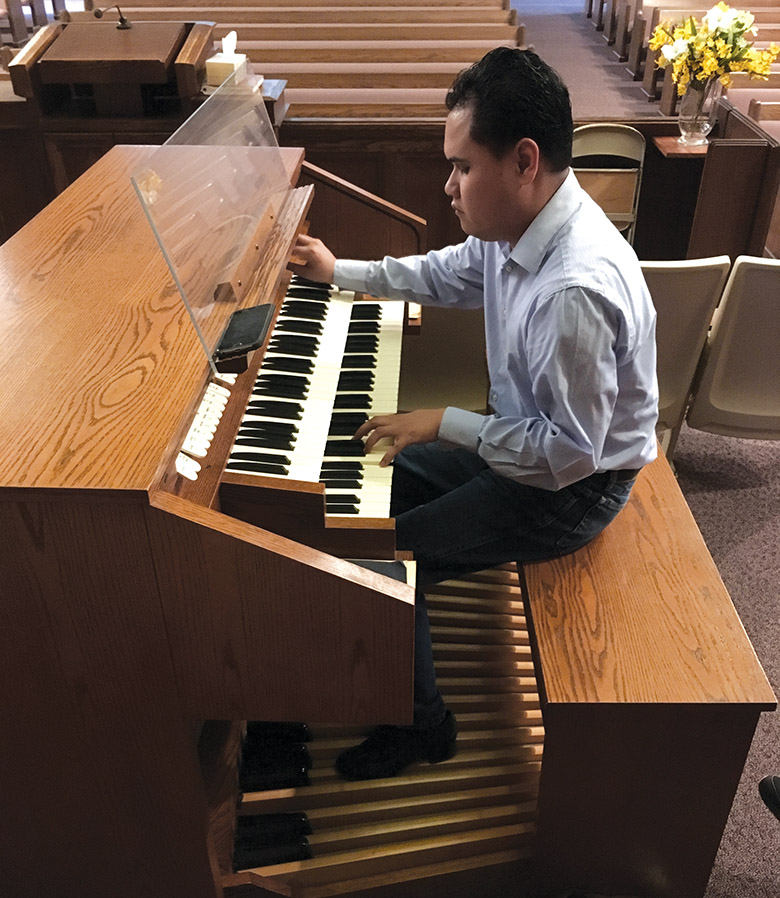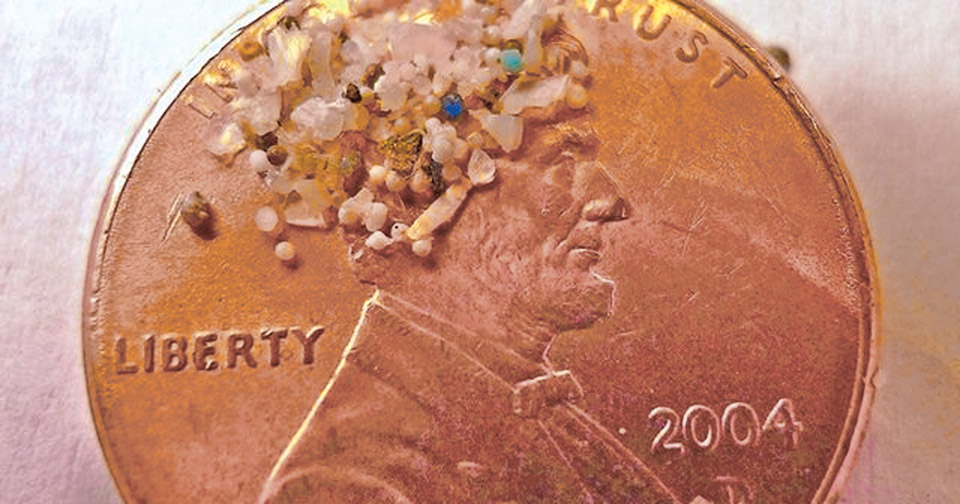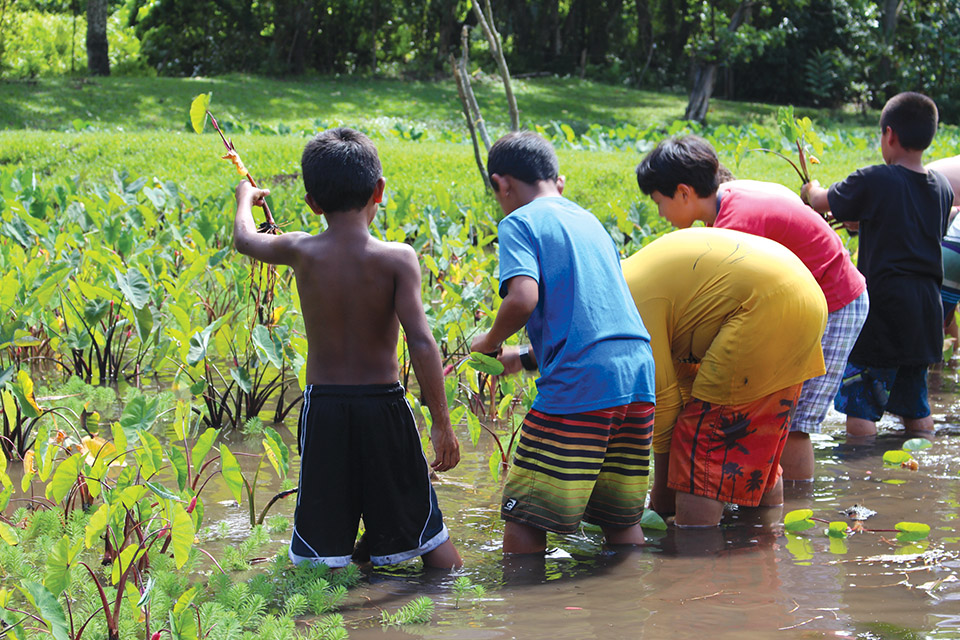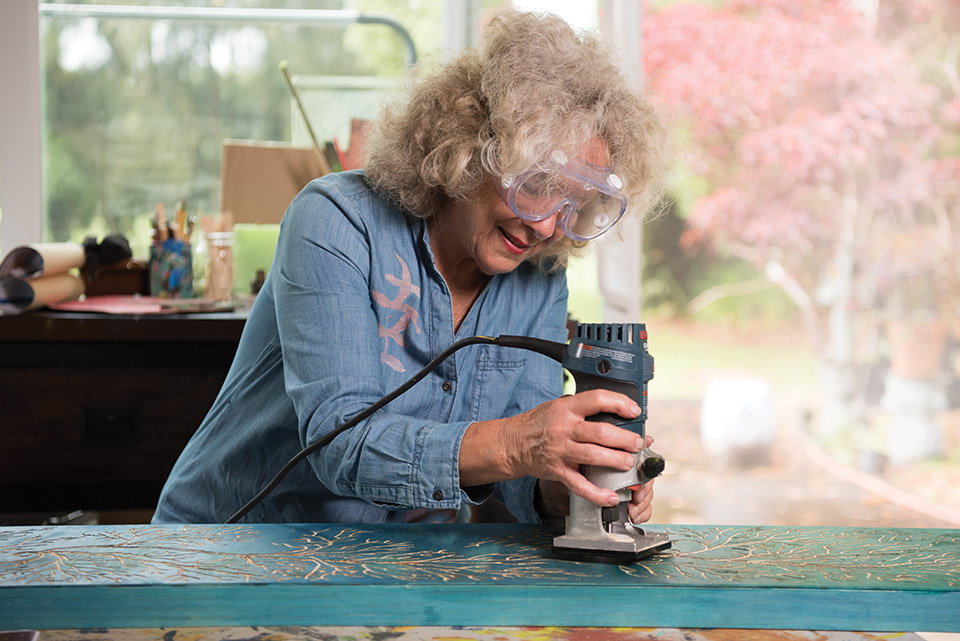
Larger Than Life: The Work of Marcia Ray

By Catherine Tarleton
“Murals for me are the most important, because they are painted to tell a story,” says Waimea artist Marcia Ray. Four of her murals, and their stories, are stretched across the upper walls of Parker Ranch Center’s Fireside Food Court: panorama-wide paintings of paniolo (cowboy) life. One, The Line-Up is a shoulder-to-shoulder string of 30 mounted cowboys in the foothills of Maunakea.
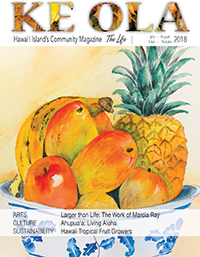
The paintings were created for the center’s re-opening in 2001. “One of the trustees said they wanted murals that represent Parker Ranch,” says Marcia. “They had a four-inch photo, and asked me ‘Can you paint this 24 feet wide?ʻ” She laughs at the memory, “I actually went to Human Resources [at Parker Ranch] to research the faces of the guys, the hats they might be wearing, their shirts, their horses.”
Helping her with this daunting project was retired Parker paniolo Jiro Yamaguchi, son of the first Japanese cowboy hired by Parker Ranch.
“Jiro would come by my studio. He loved the project,” says Marcia. “He’d say, ‘You know Massha, that stirrup is too long,’ or ‘That saddle is wrong, the spur is wrong.’ I told him, ‘Jiro, you’re my guru.’”
Marcia also interviewed community members and collected photographs from the 1920s forward. The finished product took two years to complete, and the result is more of a story than the four-inch picture could ever tell of those proud paniolo on horseback, with names people may remember, since many are related to the families dining in the food court today. “What happened was so wonderful,” says Marcia. “I really got to know the paniolo families and share their stories.”

The entire project encompassed four 24’ x 4’ murals, and 28 smaller paintings. When the murals were unveiled for the first time, Marcia remembers, “I was happy that I had enough room to paint the whole thing! That’s why I love painting big, on the Big Island. Most often, when I paint something with the mountain, I always run out of room.”
Just down the road from Parker Ranch Center, five of Marcia’s murals also grace the walls of North Hawai‘i Community Hospital. Painstakingly researched, rich in detail and kaona (deep meaning) the paintings add life and spirit to the science of the space. To help create the murals, kahuna la‘au lapa‘au (Hawaiian herbal healer) Dr. Papa Henry Auwae provided input and wisdom.
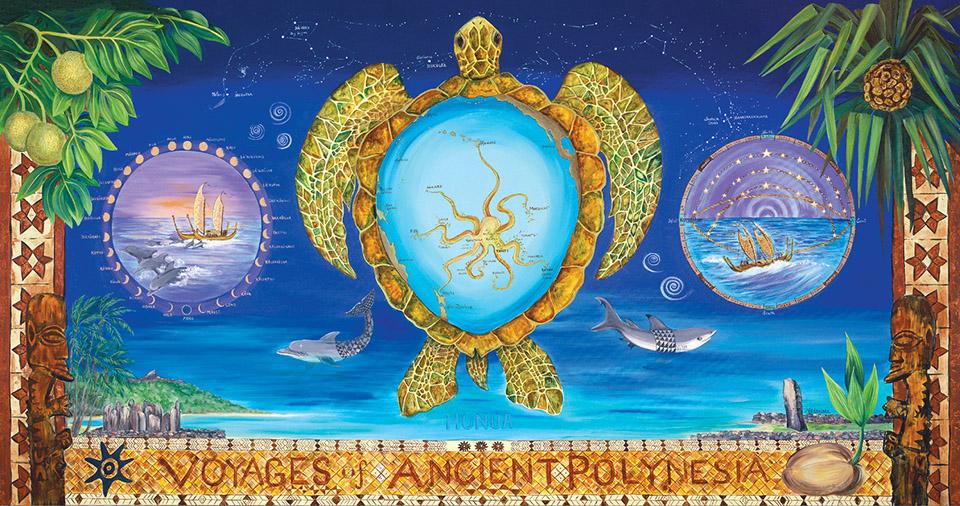
“One is in the nuclear medicine room, one of the best I’ve ever done,” says Marcia. “It’s two walls about Pu‘uhonua o Hōnaunau, a place of refuge. The mural has an eight-inch border of lauhala, with the caption ‘He pu‘wai e‘ehu ā ka pu‘uwai huikala oia’ (a healthy heart is a forgiving heart), because the nuclear medicine room is where they also do CAT scans and take care of people’s hearts.”
She continues, “The mural in the ultrasound room is about dolphins. Their echolocation is the same process as the ultrasound machine.”

Marcia’s own story begins on the East Coast. Originally from Florida, she went to the University of Arizona and studied art there, then finished at Ridgewood School of Art and Design in New Jersey. Her journey took her to the skies as a flight attendant for National Airlines in the 1960s.
“We had to wear false eyelashes, pancake makeup, stockings, and high heels,” Marcia says. “I dropped out to be a hippie and went to San Francisco. My first real job was working for a psychedelic poster company.”
Not long after, she moved to Charlottesville, Virginia and opened the area’s first vegetarian restaurant, The Natural Food Stand and Carrot Cafe. After vacationing in Hawai‘i, she moved to Hawai‘i Island and opened Paniolo Pizza, Kona’s first pizza place, in what’s now Ba Le Restaurant.
“All along, I was still painting at home. Painting has been the one constant in my life,” she says.
Although her mural works are larger than life and intricately detailed, she doesn’t think of herself primarily as a realist.
“Fantastical art is my first love,” she says. “It’s more like surrealism, which depicts real objects in unreal situations. The artist has to first master realism—to be able to paint a perfect butterfly or flower—and then place it in a fantasy setting. You have to learn how to paint realistically in order to create a good surrealist painting.”
Fascinating to the eye, Marcia’s fantasy works might bring together cross-cultural imagery and mythic elements: a bamboo fan catches the interest of a butterfly printed with hieroglyphics; a lion rests on the beach with stylized waves as a backdrop, reminiscent of Hokusai wood block prints.
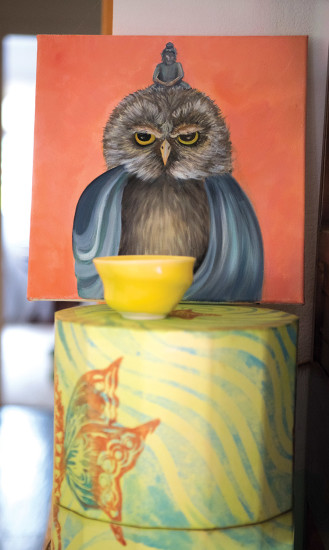
In Hawai‘i, she found a different art market, where collectors wanted to see palm trees and beaches, art representing the island. “It was a good learning curve,” she says. Marcia took her works to galleries, and started doing painted floors and painted ceilings. When the murals started to take off, she found herself on the move again.
She did six-foot paintings for the inter-island cruise ship SS Independence in the 1990’s, and murals for the Mauna Lani Bay Hotel. Two of those paintings, an octopus and a honu (turtle) shell, inspired a friend to help her find work as an artist in residence at Disney World in Orlando, back in her home state of Florida. “A year later I worked at Disney in the sign shop for Animal Kingdom,” Marcia says.
After two years in Orlando (1998-2000) she came back to visit her Hawai‘i Island home. That’s when Parker Ranch approached her for the shopping center remodel and Marcia decided to move back. Today, she can be found painting and selling her wares at the Pukalani Farmers’ Market on Saturdays, and teaching art in Anna Ranch’s “Education Barn” on Tuesday and Friday afternoons.
In between, Marcia is busy in her home studio, alive with colorful, beautiful, eclectic things from her travels, works in progress, painted furniture, books, toys, and the vibrant light of Waimea from every window. Recently, she started creating wood block prints, using a router to carve the wood blocks, and printing on paper or fabrics.
Her art encompasses many media: oil paintings, watercolors, mosaics, standing art screens, furniture, and wood carvings.
Most recently, Marcia collaborated with island artists to start the Artisans Hui at Anna Ranch, on Wednesdays from 9am to 2pm on the historic grounds of Anna Ranch Heritage Center. “It’s an artists’ market instead of a farmers’ market, featuring local artisans like wood carvers, leather workers, weavers, as well as paintings and prints of local scenes.”

One has to wonder what the mural that tells Marcia’s story would look like. She has an answer, Evolving Self Portrait, hanging, unfinished of course, on her bedroom wall. In it, a young Marcia in Hungarian dress is poised between sprays of tuberose and nasturtiums, her favorite flowers. Her left hand holds a plate with toy camel and cart (a symbol of her travels), her right hand suspends a lady marionette, a somewhat sarcastic homage to her flight attendant days. She is supported by massive stone lion pillars and behind her, translucent, veined wings.
“They’re all symbols. I love symbols,” says Marcia. “My bat wings are there to symbolize devils and angels. The lions are from Hungary, from a church where my grandfather went. The lion is my ‘aumakua (spirit guide), which I found out through hypnosis work.”
When asked what her advice is to young artists, especially young female artists, “I’d tell them to really focus on what inspires them and try to bring it out, bring it on. Don’t try to be like other people,” says Marcia. “When I was in high school, I already knew I was an artist. I was told by so many different teachers, ‘You can’t make a living as an artist, so get a real job.’ I am still working and surviving as an artist; I’ve made a living as a female artist in Hawai‘i for the last 40 years.” She continues, “I say do what you love.”
And what comes next? “My view of religion is to promote peace and try to be nice to each other. I try to portray that in my paintings,” she says. “My biggest dream would be to create a new peace sign for the planet, because when I was a young hippie, I was a peacenik. I remember some militant college folks told me, ‘When you look at the peace sign, it looks like a chicken foot. If you won’t go to war, you are chickens.’ The first thing is to come up with a new peace symbol.”
What will it look like? Hard to say, but it will probably be larger than life. ❖
For more information: MarciaRay.com
Mahalo BMW of Hawaii – Art Story Sponsor
